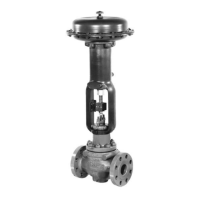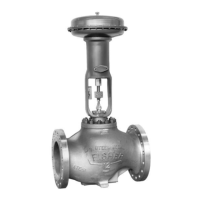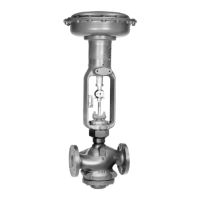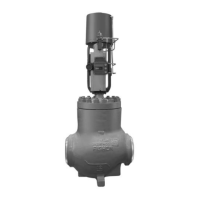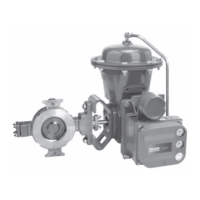Instruction Manual
D102010X012
EU and EW Series Valves
July 2017
9
valve stem is critical for making a good packing seal. If the leakage comes from the outside diameter of the packing, it
is possible that the leakage is caused by nicks or scratches around the packing box wall. If performing any of the
following procedures, inspect the valve stem and packing box wall for nicks and scratches.
Replacing Packing
1. Isolate the control valve from the line pressure, release pressure from both sides of the valve body, and drain the
process media from both sides of the valve. If using a power actuator, also shut off all pressure lines to the power
actuator, release all pressure from the actuator, and use lock‐out procedures to prevent injury while you work on
the equipment.
2. Remove any leak‐off piping from the bonnet. Disconnect the stem connector, and then remove the actuator from
the valve by unscrewing the hex nuts (key 26, figure 4).
3. Loosen the packing flange nuts (key 5, figure 4) so that the packing is not tight on the valve stem. Remove any
travel indicator parts and stem locknuts from the valve stem threads.
CAUTION
Avoid damage to the seating surfaces caused by the valve plug and stem assembly dropping from the bonnet after being
lifted part way out.
When lifting the bonnet (key 1, figure 4), either be sure that the valve plug and stem assembly remains in the valve and on
the seat or, temporarily install a valve stem locknut on the valve stem. This locknut will prevent the valve plug and stem
assembly from dropping out of the bonnet.
WARNING
To avoid personal injury or property damage caused by uncontrolled movement of the bonnet, loosen the bonnet by
following the instructions in the next step. Do not remove a stuck bonnet by pulling on it with equipment that can stretch
or store energy in any other manner. The sudden release of stored energy can cause uncontrolled movement of the bonnet.
If the cage sticks to the bonnet, proceed carefully with bonnet removal.
Note
The following step also provides additional assurance that the valve body fluid pressure has been relieved.
4. Hex nuts (key 16, figures 5 or 6) attach the bonnet to the valve body. Loosen these nuts or cap screws
approximately 3 mm (1/8 inch). Then loosen the body‐to‐bonnet gasketed joint by either rocking the bonnet or
prying between the bonnet and valve body. Work the prying tool around the bonnet until the bonnet loosens. If no
fluid leaks from the joint, remove the nuts completely and carefully lift the bonnet (key 1, figure 4).
5. Set the bonnet on a protective surface to prevent damage to the bonnet gasket surface.
6. Whenever the bonnet has been removed, replace the bonnet gasket and the cage gasket (keys 10 and 11, figures 5
and 6). Remove the bonnet gasket.
7. Lift the valve plug and stem assembly out of the valve body and set it on a protective surface. If the valve plug is to
be reused, protect the valve plug seating surface to prevent scratches.
8. Install screws or bolts into the tapped holes in the top of the cage assembly (key 3), and carefully lift it out of the
valve body. Remove the cage gasket (key 11).
9. If further trim maintenance is required, refer to the Trim Maintenance section.
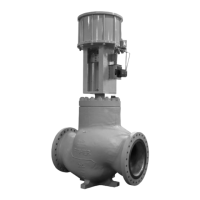
